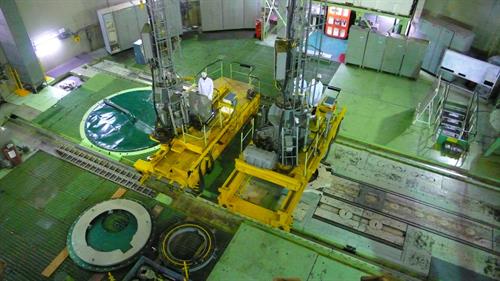PDF chapter test TRY NOW
A nuclear reactor is a device in which the nuclear fission reaction takes place in a self-sustained and controlled manner to produce electricity.
The first-ever nuclear reactor was built by Fermi in Chicago, USA, in 1942.

A nuclear reactor in a power plant
Components of a nuclear reactor:
(i) Fuel
(ii) Moderator
(iii) Control rod
(iv) Coolant
(v) Protection wall

Schematic diagram of nuclear reactor
Fuel:
Nuclear fuel is the most important part of the reactor made of fissile material. Uranium U-235 and Plutonium Pu–239 are used as fuel, out of which U-235 is the most often utilised as fuel material.
Nuclear fuel is the most important part of the reactor made of fissile material. Uranium U-235 and Plutonium Pu–239 are used as fuel, out of which U-235 is the most often utilised as fuel material.
Moderator:
A moderator is utilised to slow down the high-energy, fast-moving neutrons to produce slow neutrons. The most commonly used moderators are graphite, heavy water and beryllium oxide, out of which heavy water is the commonly used moderator.
A moderator is utilised to slow down the high-energy, fast-moving neutrons to produce slow neutrons. The most commonly used moderators are graphite, heavy water and beryllium oxide, out of which heavy water is the commonly used moderator.
The neutrons in a fission reaction have 1\ MeV of energy, and the probability of these neutrons producing a fission reaction is 500 times less than that of slow-moving neutrons. Thus, the moderator converts these fast neutrons to slow neutrons.
Control rods:
Control rods are used to maintain the chain reaction by controlling the number of neutrons. Control rods are usually made of boron or cadmium to absorb the neutrons. The rods are fixed in the walls of the reactor.
Control rods are used to maintain the chain reaction by controlling the number of neutrons. Control rods are usually made of boron or cadmium to absorb the neutrons. The rods are fixed in the walls of the reactor.
During nuclear reaction, control rods are used in two stages: shutdown and critical stages.
In the shutdown position, the control rods are completely inserted into the reactor to absorb all the emitted neutrons and to avoid any further fission reactions.
In the critical stage, the control rods are taken out of the reactor when the right number of neutrons is available to maintain the controlled fission reaction at the required rate.
Coolant:
A coolant is mainly used to produce steam by removing the heat produced in the reactor core. This steam helps to run a turbine to generate electricity. Some of the coolants are water, air and helium. Molten sodium is the most efficient and commonly used coolant.
A coolant is mainly used to produce steam by removing the heat produced in the reactor core. This steam helps to run a turbine to generate electricity. Some of the coolants are water, air and helium. Molten sodium is the most efficient and commonly used coolant.
Protection wall:
A thick, strong concrete lead wall is created around the nuclear reactor to keep hazardous radiation from escaping into the environment.
A thick, strong concrete lead wall is created around the nuclear reactor to keep hazardous radiation from escaping into the environment.
Reference:
https://upload.wikimedia.org/wikipedia/commons/1/10/Magnox_reactor_schematic.svg
